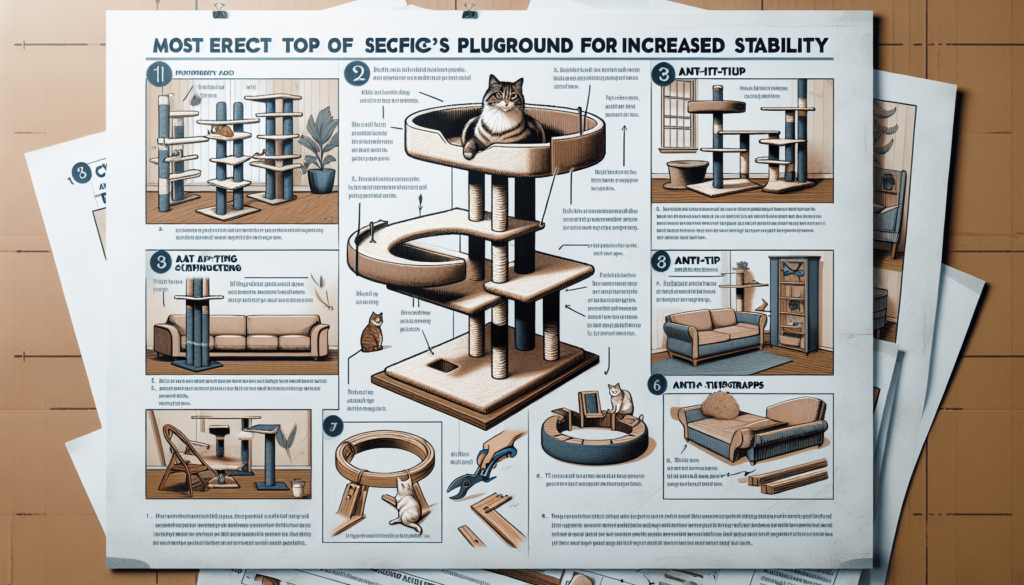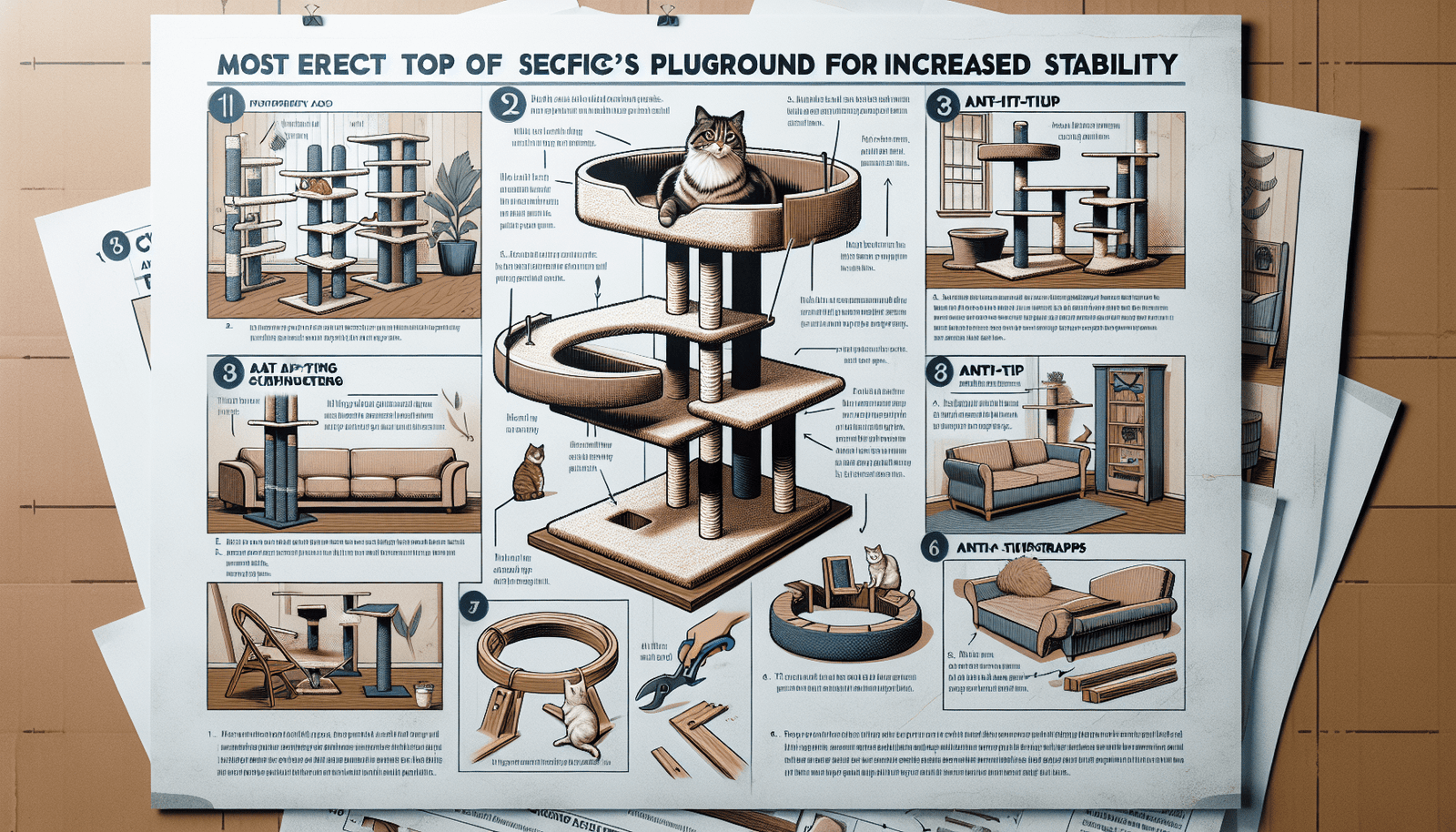Are you tired of your cat’s furniture wobbling and tipping over? In this article, you will learn the best ways to secure a cat furniture set for added stability. By following these simple tips and tricks, you can ensure that your feline friend’s furniture stays in place, keeping them safe and happy. From using brackets and straps to anchoring the furniture to the wall, you’ll find all the information you need to provide a secure and stable environment for your beloved pet. Say goodbye to wobbly cat trees and scratching posts with these easy solutions. Have you ever noticed your cat’s favorite tower starting to wobble or tip over with each jump? You’re not alone! Many cat owners struggle with keeping their feline furniture stable and secure for their pets to play on. In this article, we will explore the best ways to secure a cat furniture set for added stability. Your furry friend deserves a safe and sturdy place to climb and relax, so let’s dive into some effective solutions to keep your cat’s furniture secure and steady.

Why Is Stability Important for Cat Furniture?
Ensuring that your cat’s furniture is stable and secure is crucial for their safety and comfort. Cats are natural climbers and love to jump and explore high places. If their furniture is not stable, it can lead to accidents and injuries. Additionally, a wobbly cat tree or tower can cause stress and anxiety for your feline friends, as they may feel insecure and wary of using it. By providing a stable and secure environment for your cat, you can create a safe and happy space for them to play, nap, and sharpen their claws.
Your cat’s safety and well-being should always be a top priority. Stability is essential to prevent accidents and injuries while ensuring your feline friend feels secure in their environment.
Factors Affecting Stability of Cat Furniture
Several factors can affect the stability of your cat’s furniture, including the quality of materials, construction, and placement. Understanding these factors can help you identify weak points in your cat’s furniture and take necessary steps to improve its stability. Let’s take a closer look at the key factors that can impact the stability of cat furniture:
Consider the quality of materials: Cat furniture made from sturdy and durable materials, such as solid wood or heavy-duty carpeting, is more likely to be stable and secure. Lower-quality materials may not withstand the weight and activity of your cat, leading to instability.
Evaluate the construction: The design and construction of cat furniture play a significant role in its stability. Look for furniture with reinforced joints, thick scratching posts, and a wide base to prevent tipping over. Poorly constructed cat furniture is more prone to wobbling and collapsing.
Take into account the placement: Where you position your cat’s furniture can impact its stability. Placing it on an uneven surface, near a high-traffic area, or close to a heat source can compromise its stability. Choose a flat and stable location away from doors and windows to ensure your cat’s furniture remains secure.
Tips for Securing Cat Furniture
Now that we’ve discussed why stability is important and the factors that can affect your cat’s furniture, let’s explore some practical tips for securing cat furniture and ensuring added stability. By following these tips, you can create a safe and sturdy environment for your feline friend to enjoy their playtime and relaxation:
Use anchoring devices: Anchoring devices, such as wall straps, brackets, or screws, can help secure your cat’s furniture to a wall or floor for added stability. These devices are easy to install and can prevent tipping over or wobbling. Make sure to follow the manufacturer’s instructions when using anchoring devices.
Reinforce weak spots: Inspect your cat’s furniture for any weak spots or areas that may be prone to instability. You can reinforce these areas by adding additional support, such as extra screws, brackets, or wood glue. Strengthening weak spots can improve the overall stability of your cat’s furniture.
Trim excess height: If your cat’s furniture is too tall or top-heavy, consider trimming down the excess height to make it more stable. Lowering the height of the furniture can reduce the risk of tipping over and provide a safer environment for your cat to climb and explore.
Add weight to the base: Placing heavy objects, such as books or weights, at the base of your cat’s furniture can help prevent tipping over. Adding weight to the base can increase stability and make the furniture more secure for your cat to use. Make sure the added weight is secure and does not pose a risk to your cat.
Provide alternative scratching surfaces: Cats love to scratch and stretch their claws, but doing so on unstable furniture can lead to accidents. To prevent damage to your cat’s furniture and improve stability, provide alternative scratching surfaces, such as scratching posts or pads. Encouraging your cat to use these surfaces can reduce strain on their furniture and keep it stable.
Comparing Different Methods for Securing Cat Furniture
When it comes to securing your cat’s furniture, there are various methods and products available to help improve stability. To help you choose the best option for your furry friend, let’s compare different methods for securing cat furniture and their effectiveness:
| Method | Description | Effectiveness |
|---|---|---|
| Anchoring devices | Attaching furniture to a wall or floor using straps, brackets, or screws | Highly effective for preventing tipping over |
| Reinforcing weak spots | Adding additional support to areas prone to instability, such as screws, brackets, or wood glue | Effective for improving overall stability |
| Trimming excess height | Lowering the height of furniture to reduce top-heaviness, making it less prone to tipping over | Effective for improving stability |
| Adding weight to the base | Placing heavy objects at the base of furniture to increase stability and prevent tipping over | Effective for enhancing stability |
| Providing scratching surfaces | Offering alternative scratching surfaces to reduce strain on furniture and improve stability | Effective for preventing damage to furniture |
Based on the comparison of different methods for securing cat furniture, anchoring devices emerge as the most effective solution for preventing tipping over and ensuring added stability. However, combining multiple methods, such as reinforcing weak spots and adding weight to the base, can further improve the overall stability of your cat’s furniture.
Remember to choose the method that best suits your cat’s furniture and environment to create a safe and secure space for your feline friend to enjoy.

Conclusion
In conclusion, securing your cat’s furniture for added stability is essential for creating a safe and comfortable environment for your furry friend. By understanding the factors that can impact stability, following practical tips, and comparing different methods, you can effectively secure your cat’s furniture and prevent accidents and injuries. Remember to prioritize your cat’s safety and well-being, and invest in high-quality, stable furniture that meets their needs. With the right tools and techniques, you can provide a secure and stable space for your cat to climb, play, and relax without any worries. Cheers to a happy and stable environment for your beloved feline companion!

